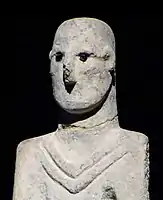Urfa Man
The Urfa man, also known as the Balıklıgöl statue, is an ancient human shaped statue found during excavations in Balıklıgöl near Urfa, in the geographical area of Upper Mesopotamia, in the southeast of modern Turkey.[1][2] It is dated c. 9000 BC to the period of the Pre-Pottery Neolithic, and is considered as "the oldest naturalistic life-sized sculpture of a human".[3] It is considered as contemporaneous with the sites of Göbekli Tepe (Pre-Pottery Neolithic A/B) and Nevalı Çori (Pre-Pottery Neolithic B).[4]
| Urfa Man | |
|---|---|
 Urfa man, in the Şanlıurfa Museum | |
| Material | Sandstone |
| Size | 1.80 meters |
| Created | c. 9000 BC |
| Present location | Şanlıurfa Museum, Turkey |
 Urfa  Urfa | |
Discovery
The statue was found during construction work, and the exact location of the find has not been properly recorded, but it may have come from the nearby Pre-Pottery Neolithic A site of Urfa Yeni-Yol.[1] This is not far from other known Pre-Pottery Neolithic A sites around Urfa: Göbekli Tepe (about 10 kilometers), Gürcütepe.[1] It is reported that it was discovered in 1993 on Yeni Yol street in Balıklıgöl, at the same location where a Pre-Pottery Neolithic site was investigated from 1997.[5]
The statue is nearly 1.90 meters tall.[6] The eyes form deep holes, in which are set segments of black obsidian.[3] It features a V-shaped collar or necklace.[5][3] The hands are clasped in front, he is holding his phallus with both hands.[5] The statue is thought to date to around 9000 BC, and is often claimed to be the oldest known statue in the world.[5][7][8]
Context
Before the Urfa Man, numerous small-sized statuettes are known from the Upper Paleolithic, such as the Löwenmensch figurine (c. 40,000 BC), the Venus of Dolní Věstonice (c. 30,000 BC), the Venus of Willendorf (c. 25000 BC) or the realistic Venus of Brassempouy (c. 25,000 BC).
Slightly later than the Urfa Man, Pre-Pottery Neolithic C, anthropomorphic statues are known from the Levant, such as the 'Ain Ghazal Statues.
Details
 Another view of the statue
Another view of the statue Urfa man portrait, with obsidian stones in the eye sockets
Urfa man portrait, with obsidian stones in the eye sockets Urfa man holding his phallus with both hands
Urfa man holding his phallus with both hands
See also
- Art of Mesopotamia
- Jericho Statue, from c. 9000 years ago, found in Tel Jericho
- 'Ain Ghazal Statues
References
- Potts, Daniel T. (2012). A Companion to the Archaeology of the Ancient Near East. John Wiley & Sons. p. 155. ISBN 9781444360776.
- Guilaine, Jean (2008). Les Racines de la Méditerranée et de l'Europe (in French). Fayard. p. 14. ISBN 9782213646268.
- Chacon, Richard J.; Mendoza, Rubén G. (2017). Feast, Famine or Fighting?: Multiple Pathways to Social Complexity. Springer. p. 120. ISBN 9783319484020.
- Laneri, Nicola (2015). Defining the Sacred: Approaches to the Archaeology of Religion in the Near East. Oxbow Books. p. 162. ISBN 9781782976837.
- Collins, Andrew (2014). Gobekli Tepe: Genesis of the Gods: The Temple of the Watchers and the Discovery of Eden. Simon and Schuster. p. 66. ISBN 9781591438359.
- Çelik, Bahattin. "Şanlıurfa - Yeni Mahalle Höyüğü in the Light of Novel C14 Analysis". (PDF) Şanlıurfa - Yeni Mahalle Höyüğü in the Light of Novel C14 Analysis. Retrieved 2020-03-05.
- Garrard-Burnett, Virginia; Yildirim, Yetkin (2011). Flying with Two Wings: Interreligious Dialogue in the Age of Global Terrorism. Cambridge Scholars Publishing. p. 133. ISBN 9781443832243.
- Schmidt, Klaus (2006). Sie bauten die ersten Tempel. Das rätselhafte Heiligtum der Steinzeitjäger. Die archäologische Entdeckung am Göbekli Tepe. München: Beck. p. 288. ISBN 978-3-406-68806-5.